April 27, 2018 @ 3:30 pm - 4:30 pm
Event Navigation
An overview of frontiers in laser-based dynamic compression experiments
Temporal pulse shaping on high power lasers systems can be used to compress materials either with near-instantaneous shock waves or, on timescales of several to tens of nanoseconds, with ramp-compression waves. Our laser-driven data obtained on the Janus and Omega laser facilities, compared to those from other dynamic compression platforms, provide information on time-dependent deformation processes related to dislocation flow, yield strength and pressure-induced structural phase transformations. Here I also present two-dimensional velocimetry data which reveal complex brittle failure and jetting behavior on shock-compressed Si samples not captured by standard velocimetry techniques.
The recent emergence of ultra-bright x-ray laser facilities such as the Stanford LCLS XFEL permits measurements of lattice level transformations under shock compression. I will describe ongoing experiments conducted at the MEC beamline in which a 50-fs monochromatic x-ray probe pulse is used to obtain high signal-to-noise diffraction patterns from shock-compressed samples to pressures above 100 GPa. Our recent data on Sn highlights the difference in phase transformation evolution due to compression timescales (static-versus-shock compression).
In the final part of the talk I will discuss laser experiments on the National Ignition Facility (NIF) with offer unprecedented opportunities to push the limits of condensed-matter and materials physics. By using ramp-compression techniques on NIF we have generated pressures over 5-TPa in carbon and 1.4 TPa in iron and measured sound speed and compressibility along a near isentropic compression path (1 TPa = 10 million atmospheres). Ramp compression produces less dissipative heating, thus enabling higher compression and lower temperature than shock compression, and ensures samples stay within the solid state to TPa pressures.
Dr. Smith received his PhD in plasma physics from the University of Essex, England. In 2002, he joined the Equation of State group at the Lawrence Livermore National Laboratory in California. His main research interests lie in the use of high power lasers to study material properties at high pressure including measurements of equation-of-state, deformation kinetics, crystal structure and thermal transport properties.





